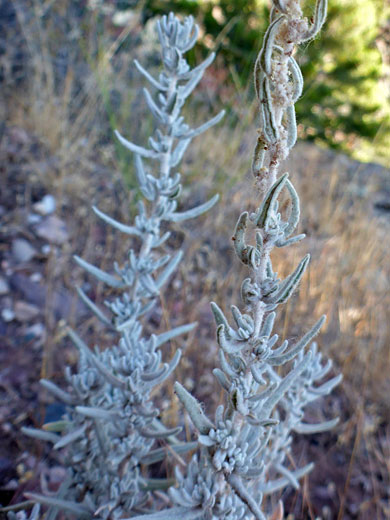
Silvery leaves of artemisia cana var viscidula, at Gates of Lodore, Dinosaur National Monument, Colorado
Common name:
Silver sagebrush
Family:
Scientific name:
Artemisia cana
Main flower color:
Range:
The northern Great Plains, the Rocky Mountain states, and all states to the west
Height:
Between 2 and 5 feet
Habitat:
Grassland, forests, meadows, streambanks; up to 10,500 feet
Leaves:
Hairy, grey-green, linear to narrowly lanceolate, up to 3 inches long
Season:
July to September
Leaves and stems of artemisia cana are usually covered by fine, greyish-white hairs, though older stems may become hairless. Stems arise from a woody trunk. The brown color of the stems is evident beneath the hairs. Plants branch freely, and the branches bear leaves all the way to the tip. Leaf margins may be rolled under. Leaves are usually simple, but they may have a few irregular lobes. Leaves are deciduous, withering before winter.
Flowerheads are produced in small clusters from the upper leaf nodes, and are subtended by narrow, leaf-like bracts. They contain between 4 and 20 tiny yellow florets. Phyllaries have the same covering as the leaves, and often their margins are indistinct due to the dense hairs.
There are three subspecies of artemisia cana. Ssp cana, generally found east of the continental divide, is a tall variety, up to 5 feet, with leaves of up to 3 inches; the other two are smaller, less than 3 feet tall, with leaves less than 2 inches: ssp bolanderi of the Pacific states has generally shorter, felt-like hairs and more greyish leaves, while ssp viscidula of the Great Basin and Rocky Mountains has longer hairs and more greenish leaves.
Flowerheads are produced in small clusters from the upper leaf nodes, and are subtended by narrow, leaf-like bracts. They contain between 4 and 20 tiny yellow florets. Phyllaries have the same covering as the leaves, and often their margins are indistinct due to the dense hairs.
There are three subspecies of artemisia cana. Ssp cana, generally found east of the continental divide, is a tall variety, up to 5 feet, with leaves of up to 3 inches; the other two are smaller, less than 3 feet tall, with leaves less than 2 inches: ssp bolanderi of the Pacific states has generally shorter, felt-like hairs and more greyish leaves, while ssp viscidula of the Great Basin and Rocky Mountains has longer hairs and more greenish leaves.
All Contents © Copyright The American Southwest | Comments and Questions | Contribute | Site Map

